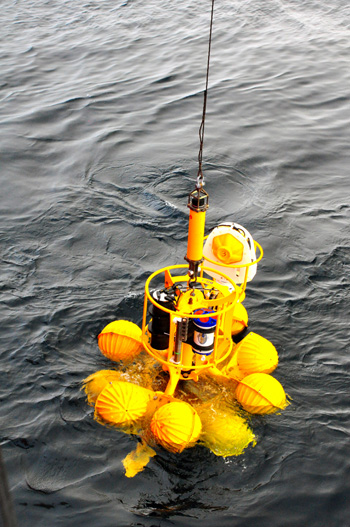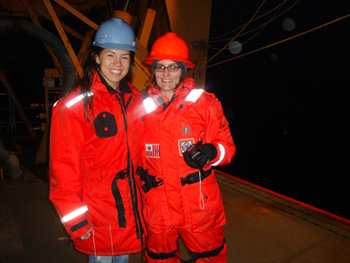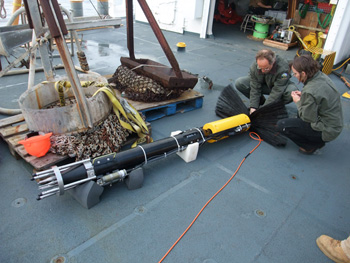September 9th
The first “tripod” instrument was released to the bottom of the ocean floor in the morning, set to record data for a year at the head of Barrow Canyon. The tripod has a weight at the bottom of approximately 1,000 pounds! Next year, when it’s time to recover the instrument, this weight is released acoustically, and the plastic-coated empty glass balls float the tripod up to the surface. Conventional environmental indicators such as temperature, salinity and velocity are recorded throughout the different seasons. Once a day at midnight a floatation device is released from the tripod and brings the sensor package to the top of the water or until it bumps the bottom of the pack-ice. It then retracts automatically back to the seafloor where the sensor package rests on the weight. This way it records a vertical profile of the temperature and salinity throughout the water column. Quite impressive. In the afternoon I joined Emily Shroyer, a post-doctoral scholar at the Woods Hole Oceanographic Institution in Massachusetts. She studies the turbulence and mixing of the ocean water (also known as microsturcure). Emily was carrying out a seventeen-hour experiment using a special profiler instrument, also known by the acronym VMP, which produces raw data telling us how the water is being stirred and mixed at small scales. Lending helping hands to the project were David Leech with the University of Alaska Fairbanks in Seward; Wilken-Jon von Appen, a third-year PhD student with Woods Hole Oceanographic Institution and originally from Germany; Benjamin Harden, a graduate student from the University of East Anglia in the UK; Matt Biddle, a recent graduate of Humbolt State interning through the Marine Advanced Technology Education (MATE) internship; and Joshua Jones with the University of California San Diego. They started at 12:30pm on Thursday and worked through the night until 4:30am on Friday – Emily is a champion! Throughout both of the major operations of the day, I was thoroughly impressed with the community that builds around science. The love of science, learning, assisting and accompanying when not necessary brings a community of people together that are inherently interested in contributing to the common good of humanity. Throughout Emily’s seventeen-hour stint of nitty-gritty science measurements and grueling sampling rates of every three minutes, the community of scientists came by, gathered, and supported Emily throughout the day and night. It was one big camp.
Last updated: September 29, 2010 | |||||||||||||||||||
Copyright ©2007 Woods Hole Oceanographic Institution, All Rights Reserved, Privacy Policy. | |||||||||||||||||||



